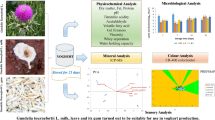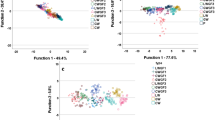Abstract
Taro (Colocasia esculenta L.) flour-based gluten-free cookies suitable for coeliac patient were developed using taro flour (40–60%), rice flour (20–25%), sorghum flour (15–20%) and cassava flour (5–15%). Cookies were developed using creamery method and evaluated for physical properties, textural analysis, proximate composition and sensory characteristics. Spread ratio of taro flour-based gluten-free cookies varied between 3.95 and 5.49, and it was decreased with increasing level of taro flour. Breaking hardness and toughness of different cookies was decreased with increasing level of taro flour in flour blends. Minerals content in taro flour-based gluten-free cookies was higher than maida-based cookie. Gluten-free cookies prepared with taro flour showed the maximum crude fiber content as compared to maida-based cookie. Results indicated that taro flour-based gluten-free cookies for coeliac patient with overall sensory acceptable can be prepared using taro flour 50% with rice flour 25%, sorghum flour 15% and cassava flour 10%.
Similar content being viewed by others
References
AACC (2000) Approved methods of the American Association of Cereal Chemists, 10th ed, USA
Aboubakar Njintang YN, Scher J, Mbofung CMF (2008) Physicochemical, thermal properties and microstructure of six varieties of taro (Colocasia esculenta L. Schott) flours and starches. J Food Eng 86:294–305
AOAC (2000) Association of Official Analytical Chemists, 17th ed, Washington
Arendt KK, O’briend CM, Schober TJ, Gormely TR, Gallagher E (2002) Development of gluten-free cereal products. Farm Food 12:21–27
Bhatnagar S, Gupta SD, Mathur M, Phillips AD, Kumar R, Knutton S, Unsworth DJ, Lock RJ, Natchu UC, Mukhopadhyaya S, Saini S, Bhan MK (2005) Celiac disease with mild to moderate histologic changes is a common cause of chronic diarrhea in Indian Children. J Pediatr Gastroenterol Nutr 41:204–209
BIS (1971) Bureau of Indian Standards. Part I and part II. Guide for sensory evaluation of foods. Indian Standard Institution, Manak Bhawan, New Delhi
Bradbury JH, Holbway WD (1988) Chemistry of tropical root crops: significance for nutrition and agriculture in the Pacific. Australian Center for International Agricultural Research, Canberra, p 201
Cowan JA (2002) Structural and catalytic chemistry of magnesium-dependent enzymes. Biometals 15:225–235
Eneche EH (1999) Biscuit making potential of millet/pigeon pea flour blends. Plant Foods Hum Nutri 54:21–27
Fasolin LH, Almeida GC, Castanho PS, Netto-Oliveira ER (2007) Cookies produced with banana meat: chemical, physical and sensory evaluation. Food Sci Tech 27:524–529
Feillet P (1988) Protein and enzyme composition of durum wheat. In: Fabriani G, Lintas C (eds) Durum wheat; chemistry and technology. AACC Inc., St. Paul, pp 93–119
Gallagher E, Germley T, Arendt E (2004) Recent advances in the formulation of gluten free cereal-based products. Trends Food Sci Tech 15:143–145
Green PHR, Jabri IB (2003) Coeliac disease. Lancet 362:383–391
Green PHR, Cellier C (2007) Coeliac disease. New Engl J Med 357:1731–1743
Hager AS, Axel C, Arendt EK (2011) Status of carbohydrates and dietary fiber in gluten-free diets. Cereal Food World 56:109–114
Hill ID, Dirks MH, Liptak GS, Colletti RB, Fasano A, Guandalini S (2005) Guideline for the diagnosis and treatment of celiac disease in children: recommendations of the North American Society for pediatric gastroenterology, hepatology and nutrition. J Pediatric Gastroenterol Nutr 40:1–19
Himeda M, Nicolas YN, Fombang E, Facho B, Kitissou P, Mbofung CMF, Scher J (2014) Chemical composition, functional and sensory characteristics of wheat-taro composite flours and biscuits. J Food Sci Tech 51(9):1893–1901
Hooda J, Jood S (2005) Organoleptic and nutritional evaluation of wheat biscuits supplemented with untreated and treated fenugreek flour. Food Chem 90:427–435
Isabelle LB, Souza EL, Felexs SS, Madruga MS, Yamashita F, Magnani M (2015) Nutritional and sensory characteristics of gluten free quinoa (chenopodium quinoa wild) based cookies development using an experimental mixture design. J Food Sci Technol 52(9):5866–5873
Jisha S, Padmaja G (2009) Whey protein concentrate fortified baked goods from cassava-based composite flours. Nutritional and functional properties. Food Bioprocess Tech. https://doi.org/10.1007/S/1947-008-0175-6
Jisha S, Padmaja G, Sajeev MS (2010) Nutritional and textural studies on dietary fiber-enriched muffins and biscuits from cassava based composite flours. J Food Quality 33:79–99
Kar S, Roy P, Ghosh M, Bhattacharya DK (2012) Utilization of seed protein concentrates in making protein rich biscuits. Indian J Inf Sci Appli 2(1):7–14
Kaur M, Kaushal P, Sandhu KS (2011) Studies on physicochemical and pasting properties of taro (Colocasia esculenta L.) flour in comparison with a cereal, tuber and legume flour. J Food Sci Tech. https://doi.org/10.1007/s13197-010-0227-6
Kaushal P, Kumar V, Sharma HK (2013) Utilization of taro (Colocasia esculenta): a review. J Food Sci Tech. https://doi.org/10.1007/s13197-013-0933-y
Kaushal P, Kumar V, Sharma HK (2012) Comparative study of physicochemical, functional, antinutritional and pasting properties of taro (Colocasia esculenta), rice (Oryza sativa) flour, pigeonpea (Cajanus cajan) flour and their blends. Lebensm-Wissu-Technol 48:59–68
Lambert M (1982) Taro cultivation in the South Pacific. South Pacific Commission, Noumea
Mareti MC, Grossmann MVE, Benassi MT (2010) Physical and sensorial characteristics of cookies containing defatted soy flour and oat bran. Food Sci Tech 4:878–883
Mcwatters KII (1978) Cookie baking properties of defatted peanut, soybean and field pea flours in baking powder biscuits. Cereal Chem 55:853–863
Mishra A, Devi M, Jha P (2015) Development of gluten free biscuits utilizing fruits and starchy vegetable powders. J Food Sci Technol 52(7):4423–4431
Nip WK (1997) Taro. In: Smith DS, Nip WK, Hui VH (eds) Processing vegetables science and technology, 1st edn. Technomic Publishing, Lancaster, pp 355–388
Nip WK, Whitaker CS, Vargo D (1994) Application of taro flour in cookie formulation. Int J Food Sci Tech 29(4):463–468
Njintang NY, Parker ML, Moates GK, Faulds CB, Smith AC, Waldron KW, Mbofung CMF, Scher J (2008) Microstructure and creep recovery characteristics of achu (a taro based paste) made from freeze dried taro chips as affected by moisture content and variety. J Food Eng 87:172–180
Njintang YN, Boudjeko T, Tatsadjieu NL, Nguema-One E, Scher J, Mbofung CMF (2011) Compositional, spectroscopic and rheological analyses of mucilage isolated from taro (Colocasia esculenta L. Schott) corms. J Food Sci Tech. https://doi.org/10.1007/s13197-011-0580-0
Onweluzo JC, Iwezu EN (1998) Composition and characteristics of cassava–soybean and wheat–soybean biscuits. J Food Sci Tech 35(2):128–131
Onwueme IC (1994) Tropical root and tuber crops production, perspectives and future prospects. FAO plant production and protection paper 126. FAO, Rome, p 228
Osredkar J, Sustar N (2011) Copper and Zinc, Biological role and significance of copper/zinc imbalance. J Clin Toxi S3(001):3–18. https://doi.org/10.4172/2161-0495.S3-001
Patel MM, Rao GV (1996) Effect of untreated, roasted and sprouted black gram (Phaseolus mungo) flours on the physic-chemical and biscuits (cookie) making characteristics of soft wheat flour. J Cereal Sci 22:285–291
Reilly NR, Green PHR (2012) Epidemiology and clinical presentations of celiac disease. Semin Immunopathol 1:6
Rubio-Tapia A, Murray JA (2010) Coeliac disease. Curr Opin Gastroenterol 26:116–122
Sarabhai S, Indrani D, Vijaykrishnaraj M, Milind Arunkumar V, Prabhasankar P (2015) Effect of protein concentrates, emulcifiers on textural and sensory characteristics of gluten free cookies and its immunochemical validation. J Food Sci Tech 52(6):3763–3772
SAS (2010) SAS Institute Inc. Cary, NC, p 2010
Sciarini SL, Ribotta DP, Leon EA, Perez TG (2008) Influence of gluten free flours and their mixtures on batter properties and bread quality. Food Bioprocess Tech 10:12. https://doi.org/10.1007/s11947-008-0098-2
Singh B, Balaji M, Kaur A, Sharma S, Sindhu S (1993) Studies on the development of high protein biscuits from composite flours. Plants Foods Hum Nutr 43:181–189
Singh R, Singh G, Chauhan GS (1996) Effects of incorporation of defatted soy flour on the quality of biscuits. J Food Sci 33:355–357
Wills RBH, Lim JSK, Greenfield H, Bayliss Smith T (1983) Nutrient composition of taro (Colocasia esculenta) cultivars from Papua New Guinea Highlands. J Sci Food Agric 34:1137–1142
Yaccha SK, Misra S, Malik AK, Nagi B, Mehta S (1993) Spectrum of mal absorption syndrome in North Indian Children. Indian J Gastroenterol 12:120–125
Acknowledgements
The authors acknowledge the support and facilities provided by the Director, ICAR-CTCRI for the study. The help extended by Dr. G. Padmaja, Emeritus scientist, is gratefully acknowledged.
Author information
Authors and Affiliations
Corresponding author
Ethics declarations
Conflict of interest
Authors declare that there is no conflict of interest.
Additional information
Publisher's Note
Springer Nature remains neutral with regard to jurisdictional claims in published maps and institutional affiliations.
Rights and permissions
About this article
Cite this article
Giri, N.A., Sajeev, M.S. Physico-Mechanical and Nutritional Evaluation of Taro (Colocasia esculenta) Flour-based Gluten-free Cookies. Agric Res 9, 125–131 (2020). https://doi.org/10.1007/s40003-019-00411-z
Received:
Accepted:
Published:
Issue Date:
DOI: https://doi.org/10.1007/s40003-019-00411-z




